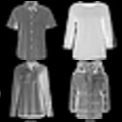Capsule networks are a type of neural network that have recently gained increased popularity. They consist of groups of neurons, called capsules, which encode properties of objects or object parts. The connections between capsules encrypt part-whole relationships between objects through routing algorithms which route the output of capsules from lower level layers to upper level layers. Capsule networks can reach state-of-the-art results on many challenging computer vision tasks, such as MNIST, Fashion-MNIST, and Small-NORB. However, most capsule network implementations use two to three capsule layers, which limits their applicability as expressivity grows exponentially with depth. One approach to overcome such limitations would be to train deeper network architectures, as it has been done for convolutional neural networks with much increased success. In this paper, we propose a methodology to train deeper capsule networks using residual connections, which is evaluated on four datasets and three different routing algorithms. Our experimental results show that in fact, performance increases when training deeper capsule networks. The source code is available on https://github.com/moejoe95/res-capsnet.
翻译:Capsule 网络是最近越来越受欢迎的一种神经网络,由神经神经元组组成,称为胶囊,对物体或物体部件的特性进行编码。胶囊之间通过路径算法将物体之间的部分整体关系加密,这种算法将胶囊的输出从下层到上层进行。 Capsule 网络可以在许多具有挑战性的计算机视觉任务上达到最先进的结果,如MNIST、Fashon-MNIST和Small-NORB。然而,大多数胶囊网络的实施使用两到三个胶囊层,这限制了它们的可应用性,因为它们的表达性会随着深度的深度而迅速增长。克服这些限制的一个办法是对网络结构进行更深层次的培训,正如对革命性神经网络所做的那样,并取得了更大的成功。在本文件中,我们提出了一个利用剩余连接来培训更深的胶囊网络的方法,该方法在四个数据集和三个不同的路径算法上进行评估。我们的实验结果表明,在培训更深的胶囊网络时性会增加。源代码可以在 https://github.com/mojoejoe95/ree-rescaps上查阅。




